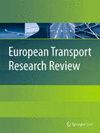实现可持续交通:公共政策工具与共享交通提供商商业模式之间的相互作用
IF 4.2
3区 工程技术
Q1 TRANSPORTATION
引用次数: 0
摘要
世界各地的城市都在试图了解,是否以及如何以一种既能激励创新、支持商业,又能促进公共价值、加快可持续发展转型的方式来管理城市交通。服务提供商也在试图了解如何通过新的交通服务、对公共空间的新利用等方式挑战现有的城市交通结构和做法,从而实现业务增长和繁荣。因此,本文试图了解商业模式与公共政策之间的相互作用,以及最终政策工具对塑造可持续城市交通条件的影响。为了解决这些问题,本文采用了定性方法,包括对在北欧三个城市(奥斯陆、斯德哥尔摩和柏林)运营的两家 "新交通 "服务提供商(Bolt 和 Tier)的案例研究,以及对这些公司和当地公共参与者的访谈。研究结果表明,商业模式受到国家层面的合法化、地方政府和服务提供商的方法以及与经营权相关的政策工具(包括上限、地理覆盖范围、停车、地理围栏和数据共享)的影响。作者利用商业模式和多层次视角,讨论了与实现可持续交通相关的研究结果,例如相互依存关系、目标一致性以及时间和空间因素。作者强调了边做边学、政策组合(相对于工具)以及利益相关者之间以目的为导向的合作的重要性。本文章由计算机程序翻译,如有差异,请以英文原文为准。
Actualizing sustainable transport: the interplay between public policy instruments and shared mobility providers’ business models
Cities around the world are trying to understand if and how to regulate urban mobility in a way that stimulates innovation and supports business while also promoting public values and accelerating a sustainability transition. Service providers are also attempting to understand how to grow and thrive as a business as they challenge existing urban mobility structures and practices via new mobility services, new uses of public space, etc. Thus, this article seeks to understand the interplay between business models and public policies and, ultimately, the implications policy instruments have on shaping conditions for sustainable urban mobility. To address these questions, a qualitative approach is utilized, comprising case studies of two ‘new mobility’ service providers (Bolt and Tier) operating in three Northern European cities (Oslo, Stockholm, and Berlin) including interviews with these companies and local public actors. Findings show that the business models are influenced by legitimization on the national level, the local authorities’ and service providers’ approaches, and policy instruments related to the right to operate, including caps, geographic coverage, parking, geofencing, and data sharing. Utilizing business models and multi-level perspectives, the findings are discussed in relation to actualizing sustainable transport, e.g. interdependencies, goal alignment, and temporal and spatial considerations. The authors emphasize the importance of learning by doing, policy mixes (versus instruments), and purpose-driven collaboration among stakeholders.
求助全文
通过发布文献求助,成功后即可免费获取论文全文。
去求助
来源期刊

European Transport Research Review
Engineering-Mechanical Engineering
CiteScore
8.60
自引率
4.70%
发文量
49
审稿时长
13 weeks
期刊介绍:
European Transport Research Review (ETRR) is a peer-reviewed open access journal publishing original high-quality scholarly research and developments in areas related to transportation science, technologies, policy and practice. Established in 2008 by the European Conference of Transport Research Institutes (ECTRI), the Journal provides researchers and practitioners around the world with an authoritative forum for the dissemination and critical discussion of new ideas and methodologies that originate in, or are of special interest to, the European transport research community. The journal is unique in its field, as it covers all modes of transport and addresses both the engineering and the social science perspective, offering a truly multidisciplinary platform for researchers, practitioners, engineers and policymakers. ETRR is aimed at a readership including researchers, practitioners in the design and operation of transportation systems, and policymakers at the international, national, regional and local levels.
 求助内容:
求助内容: 应助结果提醒方式:
应助结果提醒方式:


